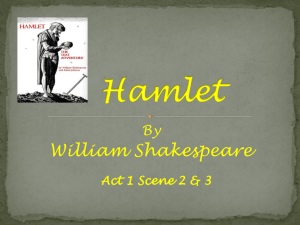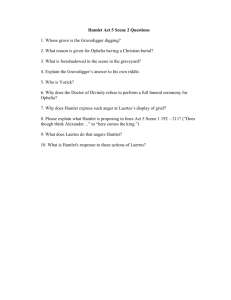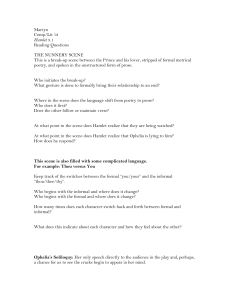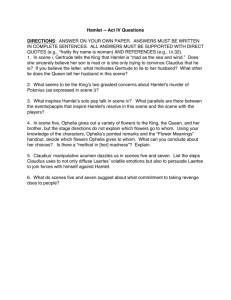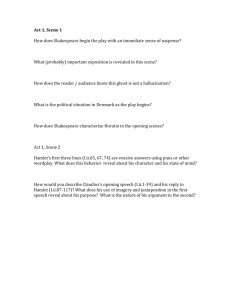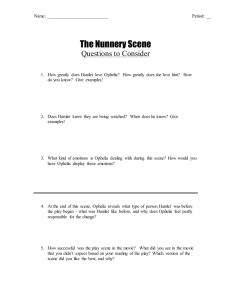Hamlet scene analysis April 3 2011
advertisement
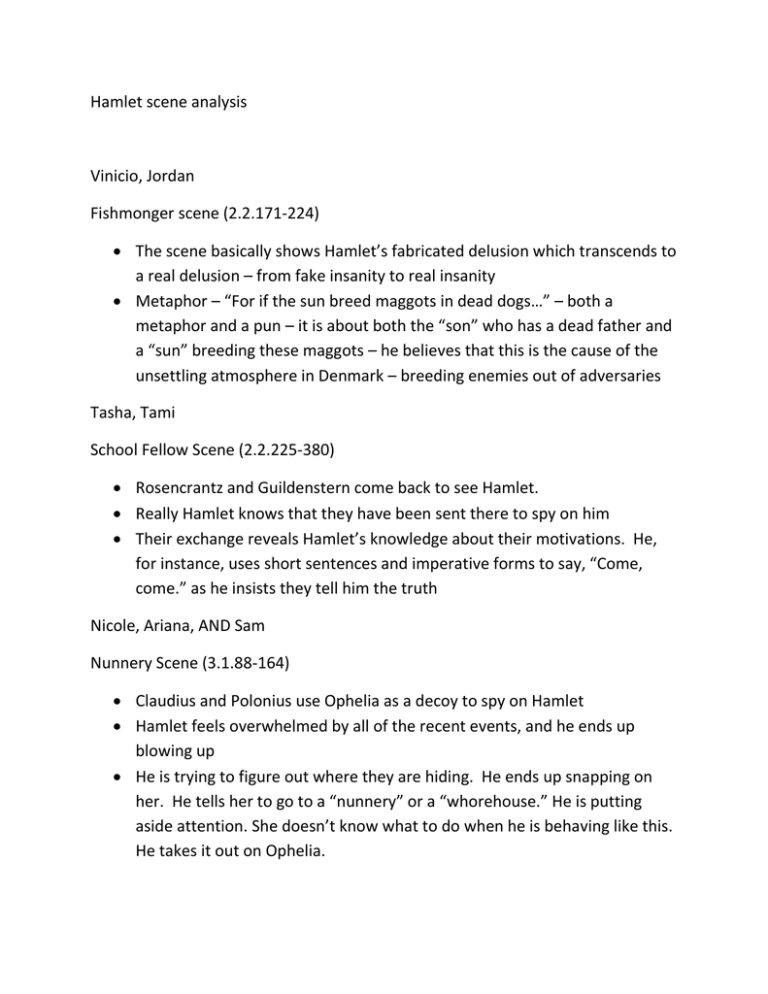
Hamlet scene analysis Vinicio, Jordan Fishmonger scene (2.2.171-224) The scene basically shows Hamlet’s fabricated delusion which transcends to a real delusion – from fake insanity to real insanity Metaphor – “For if the sun breed maggots in dead dogs…” – both a metaphor and a pun – it is about both the “son” who has a dead father and a “sun” breeding these maggots – he believes that this is the cause of the unsettling atmosphere in Denmark – breeding enemies out of adversaries Tasha, Tami School Fellow Scene (2.2.225-380) Rosencrantz and Guildenstern come back to see Hamlet. Really Hamlet knows that they have been sent there to spy on him Their exchange reveals Hamlet’s knowledge about their motivations. He, for instance, uses short sentences and imperative forms to say, “Come, come.” as he insists they tell him the truth Nicole, Ariana, AND Sam Nunnery Scene (3.1.88-164) Claudius and Polonius use Ophelia as a decoy to spy on Hamlet Hamlet feels overwhelmed by all of the recent events, and he ends up blowing up He is trying to figure out where they are hiding. He ends up snapping on her. He tells her to go to a “nunnery” or a “whorehouse.” He is putting aside attention. She doesn’t know what to do when he is behaving like this. He takes it out on Ophelia. Simile – “Be thou as chaste as ---- snow.” Hamlet is trying to figure out the level of her purity Metaphor – Ophelia compares Hamlet’s music (mind/mood) to being something that is out of tune or out of line Ophelia’s perspective at the end of the scene – Note her regrets at what he used to be e.g. his soldier, scholar, gentleman self, etc. Darrin, Manfred, Eric The Mousetrap Scene (3.2.94-216) This scene has an arranged scene by Hamlet to prove indirectly that Claudius murdered King Hamlet. Claudius cannot deal with his guilt when he sees the scene re-enacted. Hamlet is relieved, and it fuels his desire to go through with his revenge. He will go forth to pressure Claudius to admit that he killed King Hamlet Pun – Line 101-102 – “brute…to kill such a capitol a calf” – “calf” = “fool” (making fun of Polonius) Personification – “and anchor’s cheer in prison be my scope” (3.2.211) From the Player Queen, she is talking about living as a hermit with “anchors cheer” Ryan, Jacqui, Marc The Prayer Scene (3.3.36-98) The king wants to send Hamlet back to England. He is trying to assuage a conflicted conscience through prayer. Simile – Line 46 – “To wash it white as snow” – referring to a Biblical quote Imagery – Line 44- “What if this cursed hand/Were thicker than itself with brother’s blood” Simile – line 81 – Hamlet: “With all his crimes broad blown, as flush as May” As full of life – it is springtime and everything is coming in bloom – his crimes are then considered obvious like the signs of life in spring as further emphasized through the alliteration “broad blown” Yvonne, Patricia The Closet Scene (3.4.1-218) Hamlet is trying to convince his mother, Gertrude, that Claudius killed his father; meanwhile, the ghost appears, and Hamlet also has his attention drawn to that figure Symbol – a picture of the king – He tries to make her feel guilty by saying that King Hamlet was a good man and that Claudius is evil (?) Imagery – “distemper” Metaphor – “Let me wring your heart” – He will hit her in the heart and make her feel guilty. The diction choice of “wring” illustrates the almost physical action that he will conduct in his talk with her. He is aggressive with her, and he has also killed Polonius by this point in this scene. Robert, Dianna Ophelia’s madness (4.5.21-73), (4.5.154-198) Aftershock of Polonius’ death – It mostly has to do with Ophelia going mad and crazy with her grief. Quote – She was singing and weeping and feeling sad – “Larded with sweet flowers which bewept to the grave did not go…and then with true love showers” – She was singing/She is broken down and saying things that perhaps should not be said/a weird frame of mind/ The king fears consequences and Laertes returns out of nowhere. As soon as Laertes sees Ophelia in this condition, his anger increases. This reveals that Ophelia is vulnerable as a person and nothing without her father. Michael F, Jimmy 5.1.1-294 * There is a conversation between two brave figures. They discuss what happens when people die. Humans are all equal in the sight of God. The gravediggers are speaking. * Hamlet and Horatio come to the graveyard and watch the men at work. Hamlet speaks his thoughts on death and starts a conversation with the gravedigger. Meanwhile, a funeral procession interrupts their talk, and that funeral is conducted with very little ceremony. Ophelia has died, and this death and the ceremony for it surprise Hamlet. The early part of the scene concerns meditations on death with both humour and seriousness. Out of this scene comes the famous “Alas, poor Yorick” line by Hamlet as he meditates on the inevitable destiny of all people. His old playmate has died and the skull is evidence of that figure and childhood companion within the court. Hamlet’s word choice of “Alas” suggests Hamlet’s despair while his diction with “poor” illuminates his sympathy for Yorick who was an important person in Hamlet’s youth.

